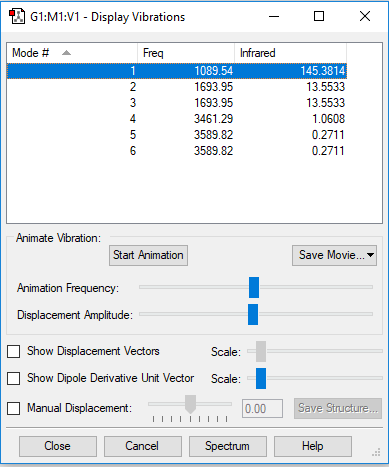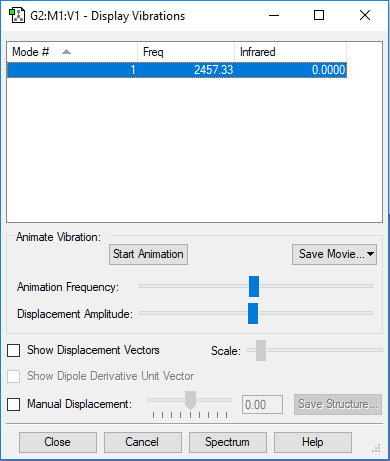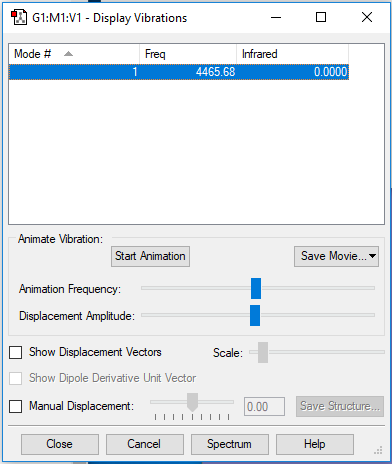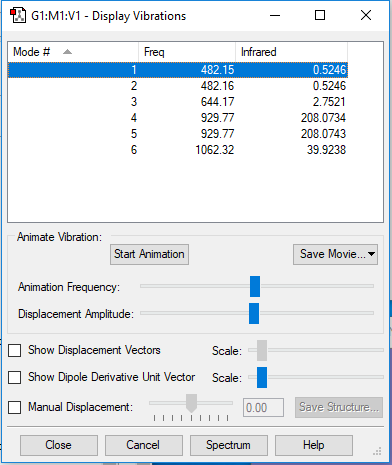User:Jw13918
NH3 molecule
What is the molecule? Ammonia.
What is the calculation method? RB3LYP
What is the basis set? 6-31G(d,p)
What is the final energy E(RB3LYP) in atomic units (au)? -56.55776873 a.u.
What is the RMS gradient? 0.00000485 a.u.
What is the point group of your molecule? C3V
Optimised N-H bond distance: 1.01798 A
Optimised H-N-H bond angle: 105.741°
Item Value Threshold Converged? Maximum Force 0.000004 0.000450 YES RMS Force 0.000004 0.000300 YES Maximum Displacement 0.000072 0.001800 YES RMS Displacement 0.000035 0.001200 YES
NH3 |
The optimisation file is liked to here
| wavenumber/cm-1 | 1090 | 1694 | 1694 | 3461 | 3590 | 3590 |
|---|---|---|---|---|---|---|
| symmetry | A1 | E | E | A1 | E | E |
| intensity/arbitrary units | 145 | 14 | 14 | 1 | 0 | 0 |
How many modes do you expect from the 3N-6 rule? 6.
Which modes are degenerate (ie have the same energy)? 2 and 3 are degenerate, 5 and 6 are degenerate.
Which modes are "bending" vibrations and which are "bond stretch" vibrations? "bending" vibrations: 1,2,3. "bond stretch" vibrations: 4,5,6.
Which mode is highly symmetric? mode 4.
One mode is known as the "umbrella" mode, which one is this? mode 1.
How many bands would you expect to see in an experimental spectrum of gaseous ammonia? 2.
Charge on the N-atom is -1.125, charge on H-atoms is +0.375 because N has higher electronegativity than H.
N2 molecule
What is the molecule? N2.
What is the calculation method? RB3LYP
What is the basis set? 6-31G(d,p)
What is the final energy E(RB3LYP) in atomic units (au)? -109.52412868 a.u.
What is the RMS gradient? 0.00000060 a.u.
What is the point group of your molecule? D*H
Optimised N-N bond distance: 1.10550 A
Optimised N-N bond angle: 180°
Item Value Threshold Converged? Maximum Force 0.000001 0.000450 YES RMS Force 0.000001 0.000300 YES Maximum Displacement 0.000000 0.001800 YES RMS Displacement 0.000000 0.001200 YES
N2 |
The optimisation file is liked to here
| wavenumber/cm-1 | 2457 |
|---|---|
| intensity/arbitrary units | 0 |
Charge on N-atoms is 0.
H2 molecule
What is the molecule? H2.
What is the calculation method? RB3LYP
What is the basis set? 6-31G(d,p)
What is the final energy E(RB3LYP) in atomic units (au)? -1.17853936 a.u.
What is the RMS gradient? 0.00000017 a.u.
What is the point group of your molecule? D*H
Optimised H-H bond distance: 0.74279 A
Optimised H-H bond angle: 180°
Item Value Threshold Converged? Maximum Force 0.000000 0.000450 YES RMS Force 0.000000 0.000300 YES Maximum Displacement 0.000000 0.001800 YES RMS Displacement 0.000001 0.001200 YES
H2 |
The optimisation file is liked to here
| wavenumber/cm-1 | 4466 |
|---|---|
| intensity/arbitrary units | 0 |
Charge on H-atoms is 0.
Crystal Structure
N-N bond distance in crystal structure is 1.112(9)A.
The crystal structure and computational distances are different. The N-N bond distance in crystal is larger because there is attraction force between N-atom and the metal ion, and then the attraction force between N-N atoms is weaker than that in N2 molecule.
Energy differences
E(NH3)= -56.55776873 a.u.
2*E(NH3)= -113.11553746 a.u.
E(N2)= -109.52412868 a.u.
E(H2)= -1.17853936 a.u.
3*E(H2)= -3.53561808 a.u.
ΔE=2*E(NH3)-[E(N2)+3*E(H2)]= -0.0557907= -146.8kJ/mol
So the ammonia product is more stable because its energy level is deeper.
NF3 molecule
What is the molecule? NF3.
What is the calculation method? RB3LYP
What is the basis set? 6-31G(d,p)
What is the final energy E(RB3LYP) in atomic units (au)? -354.07131058 a.u.
What is the RMS gradient? 0.00010256 a.u.
What is the point group of your molecule? C3V
Optimised N-F bond distance: 1.38404 A Optimised F-N-F bond angle: 101.830°
Item Value Threshold Converged? Maximum Force 0.000164 0.000450 YES RMS Force 0.000108 0.000300 YES Maximum Displacement 0.000612 0.001800 YES RMS Displacement 0.000296 0.001200 YES
NF3 |
The optimisation file is liked to here
| wavenumber/cm-1 | 482 | 482 | 644 | 930 | 930 | 1062 |
|---|---|---|---|---|---|---|
| symmetry | E | E | A1 | E | E | A1 |
| intensity/arbitrary units | 1 | 1 | 3 | 208 | 208 | 40 |
Charge on the N-atom is +0.660, charge on F-atoms is -0.200 because F has higher electronegativity than N.
MOs of NF3
 This MO is LUMO. It is unoccupied and non-bonding.
This MO is LUMO. It is unoccupied and non-bonding.
 This MO is HOMO. It is occupied and anti-bonding.
This MO is HOMO. It is occupied and anti-bonding.
 This MO is not deep in energy. It is occupied and anti-bonding.
This MO is not deep in energy. It is occupied and anti-bonding.
 This MO is not deep in energy. It is occupied and bonding.
This MO is not deep in energy. It is occupied and bonding.
 This MO is deep in energy. It is occupied and non-bonding.
This MO is deep in energy. It is occupied and non-bonding.
Addition
The NF3 bond angle in literature is 102°, compared to the optimised NF3 bond angle 101.830°.
The NH3 bond angle in literature is 107°, compared to the optimised NH3 bond angle 105.741°.
Reference
Bond angle of NF3 and NH3: <rsc.org/learn-chemistry/resource/download/res00000648/cmp00000674/pdf>
Marking
Note: All grades and comments are provisional and subjecct to change until your grades are officially returned via blackboard. Please do not contact anyone about anything to do with the marking of this lab until you have recieved your grade from blackboard.
Wiki structure and presentation 1/1
Is your wiki page clear and easy to follow, with consistent formatting?
YES
Do you effectively use tables, figures and subheadings to communicate your work?
YES
NH3 1/1
Have you completed the calculation and given a link to the file?
YES
Have you included summary and item tables in your wiki?
YES
Have you included a 3d jmol file or an image of the finished structure?
YES
Have you included the bond lengths and angles asked for?
YES
Have you included the “display vibrations” table?
YES
Have you added a table to your wiki listing the wavenumber and intensity of each vibration?
YES
Did you do the optional extra of adding images of the vibrations?
YES
Have you included answers to the questions about vibrations and charges in the lab script?
YES
N2 and H2 0/0.5
Have you completed the calculations and included all relevant information? (summary, item table, structural information, jmol image, vibrations and charges)
YES - however, you stated a bond angle for diatomic molecules. To define a bond angle a minimum of 3 atoms is needed!
Crystal structure comparison 0/0.5
Have you included a link to a structure from the CCDC that includes a coordinated N2 or H2 molecule?
NO - the given link redirects to the searching window of the CCDC. Entering LAGLAO nor LAGLAO10 redirects to a crystal structure.
Have you compared your optimised bond distance to the crystal structure bond distance?
YES
Haber-Bosch reaction energy calculation 1/1
Have you correctly calculated the energies asked for? ΔE=2*E(NH3)-[E(N2)+3*E(H2)]
YES
Have you reported your answers to the correct number of decimal places?
YES
Do your energies have the correct +/- sign?
YES
Have you answered the question, Identify which is more stable the gaseous reactants or the ammonia product?
YES
Your choice of small molecule 4/5
Have you completed the calculation and included all relevant information?
YES
Have you added information about MOs and charges on atoms?
You have done a good job of presenting this information, well done! You should have analysed the computed vibrations as you did it for NH3! You correctly commented in the occupied/unoccupied state of the MOs, their relative energies and identified the bonding/anti-bonding and non-bonding character for most of them correctly. The 3rd MO you are displaying is not anti-bonding but non-bonding. You missed to identify which AOs are contributing to the MOs.
Independence 1/1
If you have finished everything else and have spare time in the lab you could: Check one of your results against the literature, or
YES - however you could have commented in more detail on the comparison.
Do an extra calculation on another small molecule, or Do some deeper analysis on your results so far




